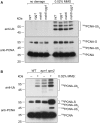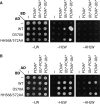PCNA monoubiquitylation and DNA polymerase eta ubiquitin-binding domain are required to prevent 8-oxoguanine-induced mutagenesis in Saccharomyces cerevisiae
- PMID: 19264809
- PMCID: PMC2677869
- DOI: 10.1093/nar/gkp105
PCNA monoubiquitylation and DNA polymerase eta ubiquitin-binding domain are required to prevent 8-oxoguanine-induced mutagenesis in Saccharomyces cerevisiae
Abstract
7,8-Dihydro-8-oxoguanine (8-oxoG) is an abundant and mutagenic DNA lesion. In Saccharomyces cerevisiae, the 8-oxoG DNA N-glycosylase (Ogg1) acts as the primary defense against 8-oxoG. Here, we present evidence for cooperation between Rad18-Rad6-dependent monoubiquitylation of PCNA at K164, the damage-tolerant DNA polymerase eta and the mismatch repair system (MMR) to prevent 8-oxoG-induced mutagenesis. Preventing PCNA modification at lysine 164 (pol30-K164R) results in a dramatic increase in GC to TA mutations due to endogenous 8-oxoG in Ogg1-deficient cells. In contrast, deletion of RAD5 or SIZ1 has little effect implying that the modification of PCNA relevant for preventing 8-oxoG-induced mutagenesis is monoubiquitin as opposed to polyubiquitin or SUMO. We also report that the ubiquitin-binding domain (UBZ) of Pol eta is essential to prevent 8-oxoG-induced mutagenesis but only in conjunction with a functional PCNA-binding domain (PIP). We propose that PCNA is ubiquitylated during the repair synthesis reaction after the MMR-dependent excision of adenine incorporated opposite to 8-oxoG. Monoubiquitylation of PCNA would favor the recruitment of Pol eta thereby allowing error-free incorporation of dCMP opposite to 8-oxoG. This study suggests that Pol eta and the post-replication repair (PRR) machinery can also prevent mutagenesis at DNA lesions that do not stall replication forks.
Figures




Similar articles
-
The post-replication repair RAD18 and RAD6 genes are involved in the prevention of spontaneous mutations caused by 7,8-dihydro-8-oxoguanine in Saccharomyces cerevisiae.Nucleic Acids Res. 2004 Sep 23;32(17):5003-10. doi: 10.1093/nar/gkh831. Print 2004. Nucleic Acids Res. 2004. PMID: 15388802 Free PMC article.
-
Repair of 8-oxo-7,8-dihydroguanine in prokaryotic and eukaryotic cells: Properties and biological roles of the Fpg and OGG1 DNA N-glycosylases.Free Radic Biol Med. 2017 Jun;107:179-201. doi: 10.1016/j.freeradbiomed.2016.11.042. Epub 2016 Nov 27. Free Radic Biol Med. 2017. PMID: 27903453 Review.
-
Opposing effects of ubiquitin conjugation and SUMO modification of PCNA on replicational bypass of DNA lesions in Saccharomyces cerevisiae.Mol Cell Biol. 2004 May;24(10):4267-74. doi: 10.1128/MCB.24.10.4267-4274.2004. Mol Cell Biol. 2004. PMID: 15121847 Free PMC article.
-
Mutations in the ubiquitin binding UBZ motif of DNA polymerase eta do not impair its function in translesion synthesis during replication.Mol Cell Biol. 2007 Oct;27(20):7266-72. doi: 10.1128/MCB.01196-07. Epub 2007 Aug 20. Mol Cell Biol. 2007. PMID: 17709386 Free PMC article.
-
Repair of 8-oxoguanine in Saccharomyces cerevisiae: interplay of DNA repair and replication mechanisms.Free Radic Biol Med. 2002 Jun 15;32(12):1244-53. doi: 10.1016/s0891-5849(02)00822-5. Free Radic Biol Med. 2002. PMID: 12057762 Review.
Cited by
-
In vivo bypass of 8-oxodG.PLoS Genet. 2013;9(8):e1003682. doi: 10.1371/journal.pgen.1003682. Epub 2013 Aug 1. PLoS Genet. 2013. PMID: 23935538 Free PMC article.
-
Cytotoxicity of Extracts from Petiveria alliacea Leaves on Yeast.Plants (Basel). 2022 Nov 27;11(23):3263. doi: 10.3390/plants11233263. Plants (Basel). 2022. PMID: 36501303 Free PMC article.
-
8-Oxoadenine: A «New» Player of the Oxidative Stress in Mammals?Int J Mol Sci. 2024 Jan 22;25(2):1342. doi: 10.3390/ijms25021342. Int J Mol Sci. 2024. PMID: 38279342 Free PMC article. Review.
-
Lsm12 Mediates Deubiquitination of DNA Polymerase η To Help Saccharomyces cerevisiae Resist Oxidative Stress.Appl Environ Microbiol. 2018 Dec 13;85(1):e01988-18. doi: 10.1128/AEM.01988-18. Print 2019 Jan 1. Appl Environ Microbiol. 2018. PMID: 30366994 Free PMC article.
-
A transient mutational burst occurs during yeast colony development.Mol Syst Biol. 2025 Jun 9. doi: 10.1038/s44320-025-00117-1. Online ahead of print. Mol Syst Biol. 2025. PMID: 40490499
References
-
- Lindahl T, Wood RD. Quality control by DNA repair. Science. 1999;286:1897–1905. - PubMed
-
- Hoeijmakers JHJ. Genome maintenance mechanisms for preventing cancer. Nature. 2001;411:366–374. - PubMed
-
- Boiteux S, Guillet M. Abasic sites in DNA: repair and biological consequences in Saccharomyces cerevisiae. DNA Repair. 2004;3:1–12. - PubMed
-
- Barnes DE, Lindahl T. Repair and genetic consequences of endogenous DNA base damage in mammalian cells. Annu. Rev. Genet. 2004;38:445–476. - PubMed
-
- Finkel T, Holbrook NJ. Oxidants, oxidative stress and the biology of ageing. Nature. 2000;408:239–247. - PubMed
Publication types
MeSH terms
Substances
Grants and funding
LinkOut - more resources
Full Text Sources
Other Literature Sources
Molecular Biology Databases
Research Materials
Miscellaneous

